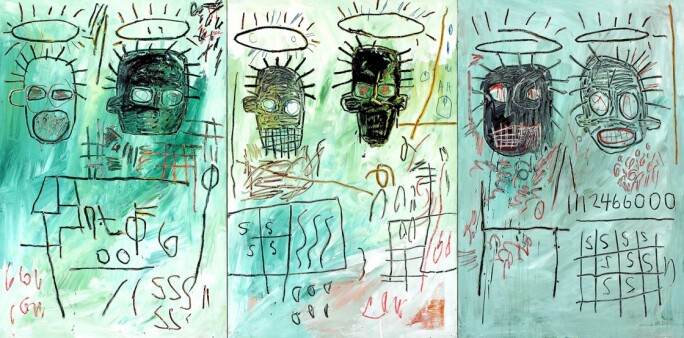
Crowns (Peso Neto), a rare and electrifying masterwork by Jean-Michel Basquiat, will form the centerpiece of Sotheby’s Contemporary Evening Auction this November when it is offered with an estimate of $35-45 million. Painted in 1981, the pivotal year that launched Basquiat onto the international stage, the work sees the artist develop and concretize the lexicon of symbols that would define his life and work, from tallies to halos to crowns. The raw canvas elements speak to a critical moment in which Basquiat transitions from the street to the studio, on the dawn of explosive stardom.
Get Auction Updates
“Painted in 1981, Crowns (Peso Neto) is a masterwork, which Jean-Michel Basquiat debuted at his landmark first solo exhibition. The canvas not only centers the emblem that has since become one of the most recognizable symbols in contemporary art but also marks the moment Basquiat announced himself to the world, setting the stage for one of the most important careers of the 20th century.”
Offered at auction for the very first time, Crowns (Peso Neto) was unveiled as part of Basquiat’s landmark eponymous solo presentation at Annina Nosei Gallery in March 1982, and the following summer at documenta 7 in Kassel, Germany, where he was among the youngest artists ever invited to participate in one of the most prestigious events on the contemporary art calendar. Its appearance at Sotheby’s comes at another historic juncture: the inauguration of its new global headquarters in the iconic Breuer building—formerly the site of the Whitney Museum of American Art, which organized the first Basquiat retrospective in 1992.

A Defining Early Masterwork
For the first time since the celebrated retrospective at the Fondation Louis Vuitton in 2018, Crowns (Peso Neto) will go on public view in London today (9—16 October), after which it will travel to Paris (20—24 October), before returning to New York ahead of the much-anticipated opening of the historic Breuer Building at 945 Madison Avenue on 8 November. Executed just three days after Basquiat's 21st birthday, the work marks the culmination of a truly ascendant year for the artist: in addition to participating in the aforementioned shows and receiving his first studio space, Basquiat had also just recently had the first extensive article written about him, with Artforum's "The Radiant Child," published in their December 1981 issue, which drew parallels between him and artistic forebearers such as Twombly and Dubuffet.
Basquiat Crowned – Property from a Distinguished European Collection
“Crowns (Peso Neto) is a defining work from the year that marked Basquiat’s rise. It embodies his fearless vision, weaving together his iconic crown motif, a profound interrogation of power and identity, and the raw immediacy that continues to resonate across generations. To present it at our new headquarters in the Breuer building, the site of Basquiat’s first major 1992 retrospective, in which it was prominently featured. is both fitting and historic.”
Emerging from the twilight of this important year, which had brought public visibility, critical acclaim and commercial success hitherto unprecedented for Basquiat, we see him meditating on this rise. Following his participation in The Times Square Show in 1980 and the watershed “New York/New Wave” exhibition at P.S.1 in early 1981, Basquiat quickly drew the attention of downtown dealer Annina Nosei, who invited him into her circle later that year. Without a studio of his own, he began working in the basement of Nosei’s gallery - now an important art historical site - where he unleashed a torrent of creativity that gave rise to many of his earliest masterpieces, including Crowns (Peso Neto). With its commanding composition, Crowns (Peso Neto) radically repositions the Western canon. Across the surface, multiple iterations of his now-iconic crown motif appear as both symbols of regality and martyrdom, challenging traditional hierarchies and asserting Black figures as kings, saints and heroes.

Hollywood Africans, 1983
Whitney Museum of American, New York
Paying homage to the vibrant street graffiti culture in New York that Basquiat both contributed to and was inspired by, text is a crucial component in Basquiat’s practice. In the present work, ‘peso’ is a legible condemnation of capitalism and racial inequity, and allusions to money and fame would continue to appear throughout the rest of his oeuvre.

Self-Portrait as a Hell (Part Two), 1982
Private Collection, sold at Sotheby’s New York in November 2023 for $42 million
Much of the figuration across Basquiat’s oeuvre is self-referential, a brief glimpse into the person behind a legendary yet brief artistic career. The astronomical rise of Basquiat’s career had innumerable effects on the artist’s self-conception – here, ‘Heel’ implies a sense of self deprecation, while cameos as a crowned figure capture moments of supreme self-assurance.

Untitled, 1981
The Broad, Los Angeles
Grids and cross-hatching are recurrent techniques of mark-making appearing across Basquiat’s canvases, at once ordered yet carrying a frenetic energy. The grid resembles stitches or sidewalk chalk games, the latter which Basquiat would have encountered during his expeditions as a street graffiti artist — perhaps too, an urban vernacular of street grids is reflected in this motif.

Trumpet, 1984
Private Collection
Amongst contemporary iconography, Basquiat’s crown is ubiquitous and varied in its meaning. At once representing untold levels of influence and status, Basquiat often placed these crowns atop skull like figures, challenging notions of power’s longevity. Basquiat employed the crown to recenter historical figures, crowning jazz legends like Charlie Parker to elevate marginalized Black artists, or atop a dinosaur figure in Pez Dispenser as a critique of consumerism.

Six Crimee, 1982
The Museum of Contemporary Art, Los Angeles
Amidst systemic racial profiling in America, the thorn of crowns is a core part of Basquiat’s visual symbolism that alludes to death, resurrection and myth-making. A variety of head adornments appear across his paintings—crowns, devil horns, hats—but the angelic halo in particular inspires a religious reverence for the figures depicted, drawing a visual analogy to the thorned crown worn by Christ.

In the stark duality of the central black and white heads, Basquiat positions himself as both heir and adversary to the legacy of the Italian Renaissance masters, while interrogating the imbalances of power embedded in art history. The title, Peso Neto (meaning “net weight” in Spanish), further extends this critique, transforming the language of trade into a commentary on art, identity, and value. Frequently drawing from his Puerto Rican heritage and time living in San Juan, Basquiat incorporated Spanish words such as pollo (chicken), mujer (woman), and oro (gold) as markers of commerce and culture; here, peso neto crystallizes his meditation on the fraught relationship between art and commerce. As the artist stood on the precipice of stardom, the term evokes both empowerment and constraint: art as a vehicle of liberation and self-expression, yet also a product bound to the mechanisms of the market.

“Most young kings get their heads cut off.”
As bell hooks wrote in Outlaw Culture, the crown in Basquiat’s work, “is not an unambiguous image; while it may positively speak of the longing for glory and power, it connects that desire to dehumanization. . . In the painting Crowns (Peso Neto) (1981), Black figures wear crowns but are sharply contrasted with the lone white figure wearing a crown, for it is that figure that looms large, overseeing a shadowy world, as well as the world of Black glory.”
Basquiat’s Crowns
The crown is Basquiat’s most recognizable motif and one of the most enduring emblems of late 20th-century art. Here his crowns are brought to the forefront, in Crowns (Peso Neto) Basquiat repeats and centralizes the motif which became a vehicle for both cultural elevation and self-reflection. By “crowning” Black figures—including athletes, musicians, and writers—Basquiat elevated historically marginalized subjects to the status of royalty and sainthood. At the same time, the crown marked his own pursuit of recognition, mocking the art world’s appetite for fame while acknowledging the sacrifices bound to ambition. Often paired with skulls or human heads, the crown also highlights the tension between power and mortality.

In Crowns (Peso Neto), these themes take on an added dimension, he scribes peso neto—“net weight” in the lower left. Here, Basquiat underscores the relationship between the crown, as a declaration of fame and power, and the commercial world into which he was entering. The phrase becomes both a literal label and a symbolic judgment, weighing artistic worth against the costs of commodification, and amplifying the painting’s meditation on triumph, sacrifice, and value.














